Detailed Analysis of UK Taxation: Income, Residence, and More
VerifiedAdded on 2022/09/07
|13
|2791
|14
Report
AI Summary
This report provides a comprehensive overview of UK taxation, focusing on individual income tax. It details the Income Tax Act 2007 and discusses various tax rates, including the basic, higher, and additional rates, based on income levels. The report emphasizes the importance of residence status in determining tax liability, differentiating between UK residents and non-residents, and explaining the criteria for each. It covers key aspects such as personal allowances, capital gains tax, and the remittance basis for non-domiciled individuals. The report also includes information on dividend allowances, tax bands, and business investment reliefs. It also touches upon the taxation of children and the absence of local income taxes. Overall, the report offers a detailed analysis of the UK tax system, providing valuable insights into its complexities and regulations, supported by relevant examples and calculations. This is a past paper available on Desklib.

Running head: UK TAXATION
UK TAXATION
Name of the Student:
Name of the University:
Author Note:
UK TAXATION
Name of the Student:
Name of the University:
Author Note:
Paraphrase This Document
Need a fresh take? Get an instant paraphrase of this document with our AI Paraphraser

1UK taxation
Executive Summary
The report will explain about the UK taxation details regarding the individual taxation. Different
rates, classes and criteria are thoroughly discussed in the report and some additional tax details
are also provided which is regulated in the country.
Executive Summary
The report will explain about the UK taxation details regarding the individual taxation. Different
rates, classes and criteria are thoroughly discussed in the report and some additional tax details
are also provided which is regulated in the country.

2UK taxation
Table of Contents
1.1 Introduction................................................................................................................................3
1.2 Discussion..................................................................................................................................3
1.3 Conclusion.................................................................................................................................9
Table of Contents
1.1 Introduction................................................................................................................................3
1.2 Discussion..................................................................................................................................3
1.3 Conclusion.................................................................................................................................9
⊘ This is a preview!⊘
Do you want full access?
Subscribe today to unlock all pages.

Trusted by 1+ million students worldwide
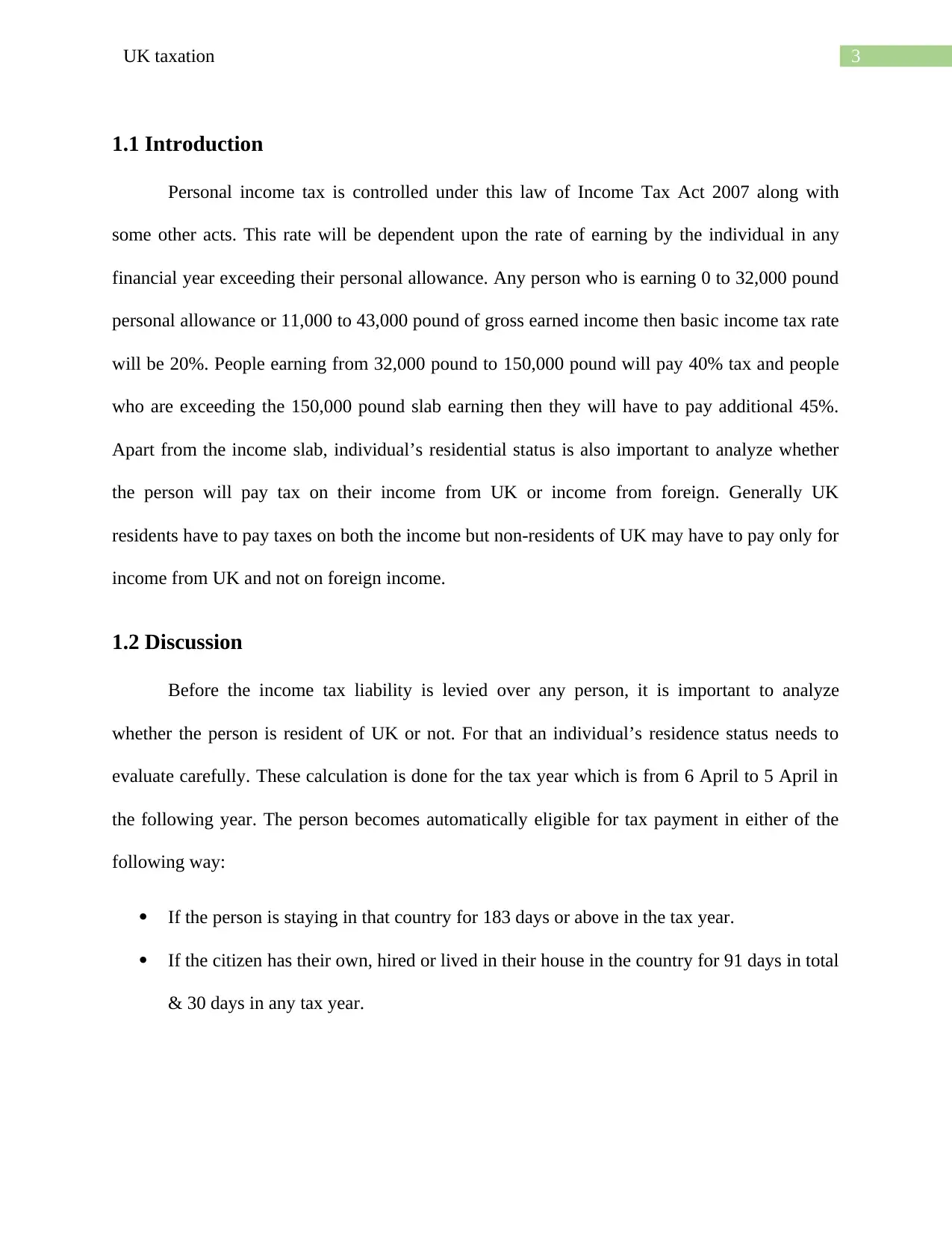
3UK taxation
1.1 Introduction
Personal income tax is controlled under this law of Income Tax Act 2007 along with
some other acts. This rate will be dependent upon the rate of earning by the individual in any
financial year exceeding their personal allowance. Any person who is earning 0 to 32,000 pound
personal allowance or 11,000 to 43,000 pound of gross earned income then basic income tax rate
will be 20%. People earning from 32,000 pound to 150,000 pound will pay 40% tax and people
who are exceeding the 150,000 pound slab earning then they will have to pay additional 45%.
Apart from the income slab, individual’s residential status is also important to analyze whether
the person will pay tax on their income from UK or income from foreign. Generally UK
residents have to pay taxes on both the income but non-residents of UK may have to pay only for
income from UK and not on foreign income.
1.2 Discussion
Before the income tax liability is levied over any person, it is important to analyze
whether the person is resident of UK or not. For that an individual’s residence status needs to
evaluate carefully. These calculation is done for the tax year which is from 6 April to 5 April in
the following year. The person becomes automatically eligible for tax payment in either of the
following way:
If the person is staying in that country for 183 days or above in the tax year.
If the citizen has their own, hired or lived in their house in the country for 91 days in total
& 30 days in any tax year.
1.1 Introduction
Personal income tax is controlled under this law of Income Tax Act 2007 along with
some other acts. This rate will be dependent upon the rate of earning by the individual in any
financial year exceeding their personal allowance. Any person who is earning 0 to 32,000 pound
personal allowance or 11,000 to 43,000 pound of gross earned income then basic income tax rate
will be 20%. People earning from 32,000 pound to 150,000 pound will pay 40% tax and people
who are exceeding the 150,000 pound slab earning then they will have to pay additional 45%.
Apart from the income slab, individual’s residential status is also important to analyze whether
the person will pay tax on their income from UK or income from foreign. Generally UK
residents have to pay taxes on both the income but non-residents of UK may have to pay only for
income from UK and not on foreign income.
1.2 Discussion
Before the income tax liability is levied over any person, it is important to analyze
whether the person is resident of UK or not. For that an individual’s residence status needs to
evaluate carefully. These calculation is done for the tax year which is from 6 April to 5 April in
the following year. The person becomes automatically eligible for tax payment in either of the
following way:
If the person is staying in that country for 183 days or above in the tax year.
If the citizen has their own, hired or lived in their house in the country for 91 days in total
& 30 days in any tax year.
Paraphrase This Document
Need a fresh take? Get an instant paraphrase of this document with our AI Paraphraser

4UK taxation
Each and every person in UK have to pay income tax but the non-residents are eligible
for paying only for the income from UK and not foreign incomes. Any person become
automatically a non-resident if:
The person spends below 16 days in UK (or for 46 days only if the citizen has not been
defined as the resident in their last 3 tax years) or
If the citizen is working in abroad for full-time ( on an average of 35 hours a week) and
then spends less than 91 days in UK among which more than 30 days were spent in
abroad for work.
When any individual moves in or out of the country, then the tax year for them will be
split into 2 parts, one for non-resident part & the other one will be for resident part. Therefore,
the person is bound to pay UK tax only for foreign income which will be dependent upon their
living time here. This system is called ‘split-year treatment’. However, the person may not get
the split-year treatment if he or she lives in abroad for less than a whole tax year before they
return to UK. Other criteria also there which needs to be met by the individual as well like the
situation changes. There are also some conditions which allows the individual to check whether
their status changed from one tax year to another tax year. The examples which can help the
individual to assess their status are following:
If the person spends more or less of their time in UK
If the person buys or sells a home in UK
If the person changes their job
If their family moves in or out of UK
If the person gets married, separated or even they have children
Each and every person in UK have to pay income tax but the non-residents are eligible
for paying only for the income from UK and not foreign incomes. Any person become
automatically a non-resident if:
The person spends below 16 days in UK (or for 46 days only if the citizen has not been
defined as the resident in their last 3 tax years) or
If the citizen is working in abroad for full-time ( on an average of 35 hours a week) and
then spends less than 91 days in UK among which more than 30 days were spent in
abroad for work.
When any individual moves in or out of the country, then the tax year for them will be
split into 2 parts, one for non-resident part & the other one will be for resident part. Therefore,
the person is bound to pay UK tax only for foreign income which will be dependent upon their
living time here. This system is called ‘split-year treatment’. However, the person may not get
the split-year treatment if he or she lives in abroad for less than a whole tax year before they
return to UK. Other criteria also there which needs to be met by the individual as well like the
situation changes. There are also some conditions which allows the individual to check whether
their status changed from one tax year to another tax year. The examples which can help the
individual to assess their status are following:
If the person spends more or less of their time in UK
If the person buys or sells a home in UK
If the person changes their job
If their family moves in or out of UK
If the person gets married, separated or even they have children
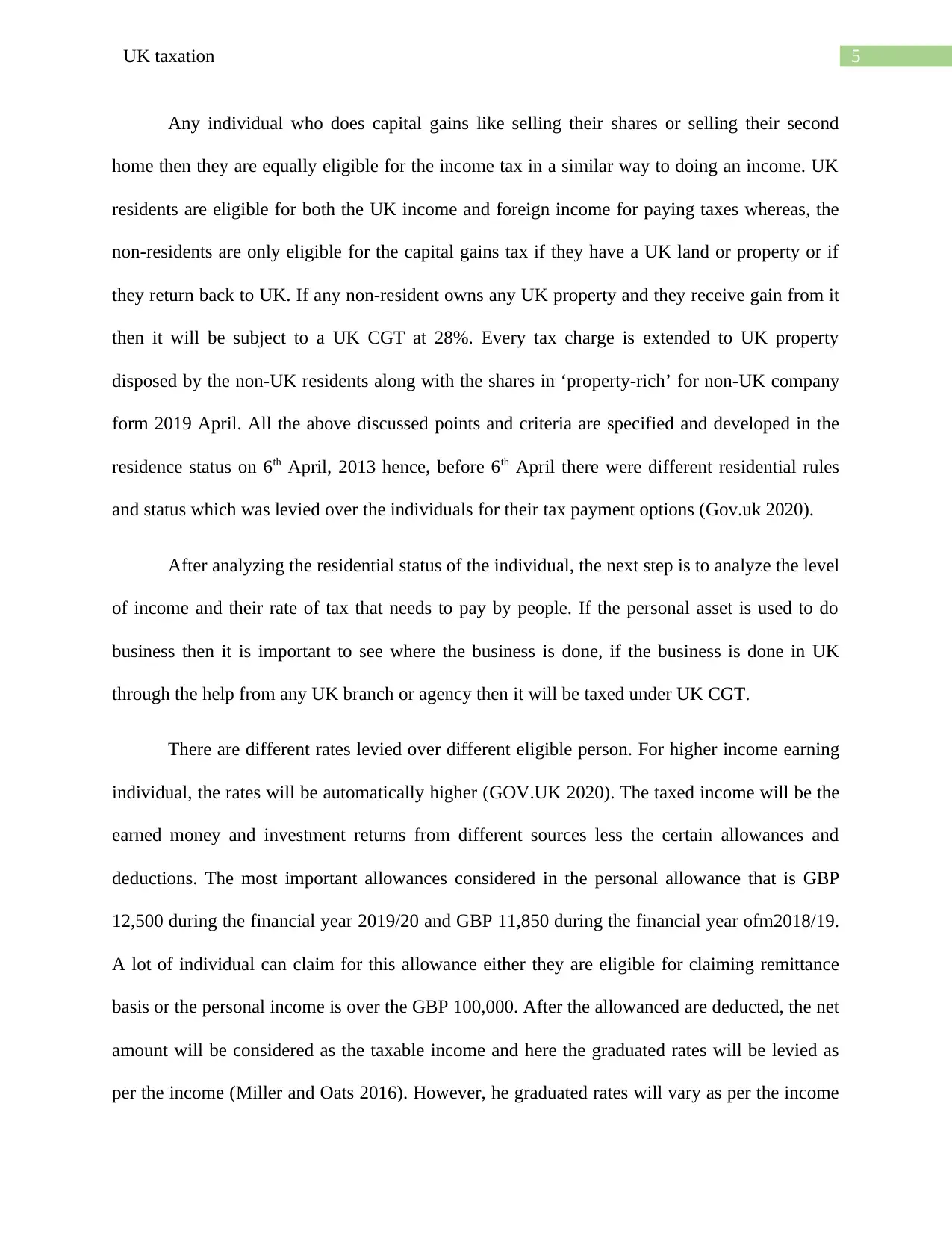
5UK taxation
Any individual who does capital gains like selling their shares or selling their second
home then they are equally eligible for the income tax in a similar way to doing an income. UK
residents are eligible for both the UK income and foreign income for paying taxes whereas, the
non-residents are only eligible for the capital gains tax if they have a UK land or property or if
they return back to UK. If any non-resident owns any UK property and they receive gain from it
then it will be subject to a UK CGT at 28%. Every tax charge is extended to UK property
disposed by the non-UK residents along with the shares in ‘property-rich’ for non-UK company
form 2019 April. All the above discussed points and criteria are specified and developed in the
residence status on 6th April, 2013 hence, before 6th April there were different residential rules
and status which was levied over the individuals for their tax payment options (Gov.uk 2020).
After analyzing the residential status of the individual, the next step is to analyze the level
of income and their rate of tax that needs to pay by people. If the personal asset is used to do
business then it is important to see where the business is done, if the business is done in UK
through the help from any UK branch or agency then it will be taxed under UK CGT.
There are different rates levied over different eligible person. For higher income earning
individual, the rates will be automatically higher (GOV.UK 2020). The taxed income will be the
earned money and investment returns from different sources less the certain allowances and
deductions. The most important allowances considered in the personal allowance that is GBP
12,500 during the financial year 2019/20 and GBP 11,850 during the financial year ofm2018/19.
A lot of individual can claim for this allowance either they are eligible for claiming remittance
basis or the personal income is over the GBP 100,000. After the allowanced are deducted, the net
amount will be considered as the taxable income and here the graduated rates will be levied as
per the income (Miller and Oats 2016). However, he graduated rates will vary as per the income
Any individual who does capital gains like selling their shares or selling their second
home then they are equally eligible for the income tax in a similar way to doing an income. UK
residents are eligible for both the UK income and foreign income for paying taxes whereas, the
non-residents are only eligible for the capital gains tax if they have a UK land or property or if
they return back to UK. If any non-resident owns any UK property and they receive gain from it
then it will be subject to a UK CGT at 28%. Every tax charge is extended to UK property
disposed by the non-UK residents along with the shares in ‘property-rich’ for non-UK company
form 2019 April. All the above discussed points and criteria are specified and developed in the
residence status on 6th April, 2013 hence, before 6th April there were different residential rules
and status which was levied over the individuals for their tax payment options (Gov.uk 2020).
After analyzing the residential status of the individual, the next step is to analyze the level
of income and their rate of tax that needs to pay by people. If the personal asset is used to do
business then it is important to see where the business is done, if the business is done in UK
through the help from any UK branch or agency then it will be taxed under UK CGT.
There are different rates levied over different eligible person. For higher income earning
individual, the rates will be automatically higher (GOV.UK 2020). The taxed income will be the
earned money and investment returns from different sources less the certain allowances and
deductions. The most important allowances considered in the personal allowance that is GBP
12,500 during the financial year 2019/20 and GBP 11,850 during the financial year ofm2018/19.
A lot of individual can claim for this allowance either they are eligible for claiming remittance
basis or the personal income is over the GBP 100,000. After the allowanced are deducted, the net
amount will be considered as the taxable income and here the graduated rates will be levied as
per the income (Miller and Oats 2016). However, he graduated rates will vary as per the income
⊘ This is a preview!⊘
Do you want full access?
Subscribe today to unlock all pages.

Trusted by 1+ million students worldwide
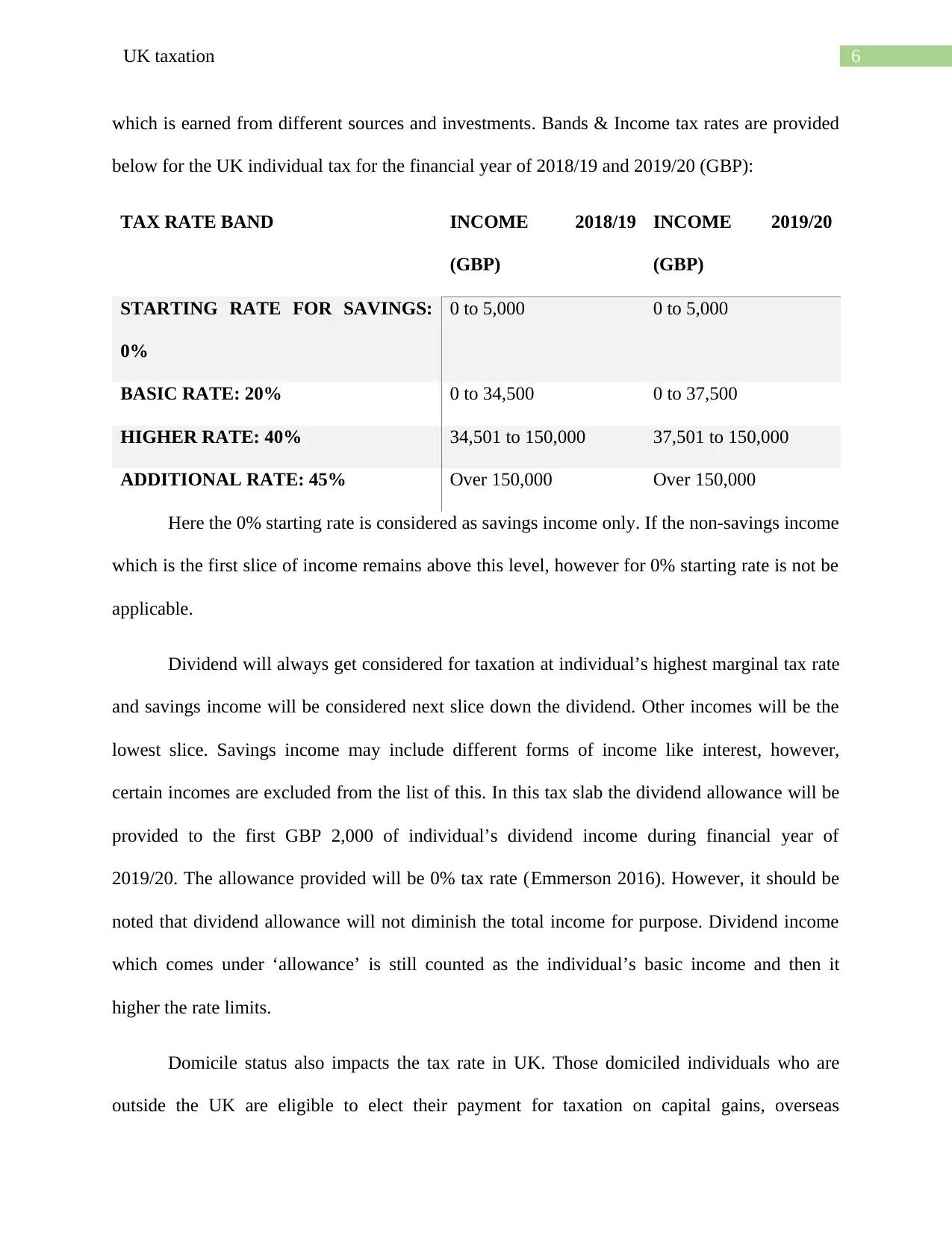
6UK taxation
which is earned from different sources and investments. Bands & Income tax rates are provided
below for the UK individual tax for the financial year of 2018/19 and 2019/20 (GBP):
TAX RATE BAND INCOME 2018/19
(GBP)
INCOME 2019/20
(GBP)
STARTING RATE FOR SAVINGS:
0%
0 to 5,000 0 to 5,000
BASIC RATE: 20% 0 to 34,500 0 to 37,500
HIGHER RATE: 40% 34,501 to 150,000 37,501 to 150,000
ADDITIONAL RATE: 45% Over 150,000 Over 150,000
Here the 0% starting rate is considered as savings income only. If the non-savings income
which is the first slice of income remains above this level, however for 0% starting rate is not be
applicable.
Dividend will always get considered for taxation at individual’s highest marginal tax rate
and savings income will be considered next slice down the dividend. Other incomes will be the
lowest slice. Savings income may include different forms of income like interest, however,
certain incomes are excluded from the list of this. In this tax slab the dividend allowance will be
provided to the first GBP 2,000 of individual’s dividend income during financial year of
2019/20. The allowance provided will be 0% tax rate (Emmerson 2016). However, it should be
noted that dividend allowance will not diminish the total income for purpose. Dividend income
which comes under ‘allowance’ is still counted as the individual’s basic income and then it
higher the rate limits.
Domicile status also impacts the tax rate in UK. Those domiciled individuals who are
outside the UK are eligible to elect their payment for taxation on capital gains, overseas
which is earned from different sources and investments. Bands & Income tax rates are provided
below for the UK individual tax for the financial year of 2018/19 and 2019/20 (GBP):
TAX RATE BAND INCOME 2018/19
(GBP)
INCOME 2019/20
(GBP)
STARTING RATE FOR SAVINGS:
0%
0 to 5,000 0 to 5,000
BASIC RATE: 20% 0 to 34,500 0 to 37,500
HIGHER RATE: 40% 34,501 to 150,000 37,501 to 150,000
ADDITIONAL RATE: 45% Over 150,000 Over 150,000
Here the 0% starting rate is considered as savings income only. If the non-savings income
which is the first slice of income remains above this level, however for 0% starting rate is not be
applicable.
Dividend will always get considered for taxation at individual’s highest marginal tax rate
and savings income will be considered next slice down the dividend. Other incomes will be the
lowest slice. Savings income may include different forms of income like interest, however,
certain incomes are excluded from the list of this. In this tax slab the dividend allowance will be
provided to the first GBP 2,000 of individual’s dividend income during financial year of
2019/20. The allowance provided will be 0% tax rate (Emmerson 2016). However, it should be
noted that dividend allowance will not diminish the total income for purpose. Dividend income
which comes under ‘allowance’ is still counted as the individual’s basic income and then it
higher the rate limits.
Domicile status also impacts the tax rate in UK. Those domiciled individuals who are
outside the UK are eligible to elect their payment for taxation on capital gains, overseas
Paraphrase This Document
Need a fresh take? Get an instant paraphrase of this document with our AI Paraphraser
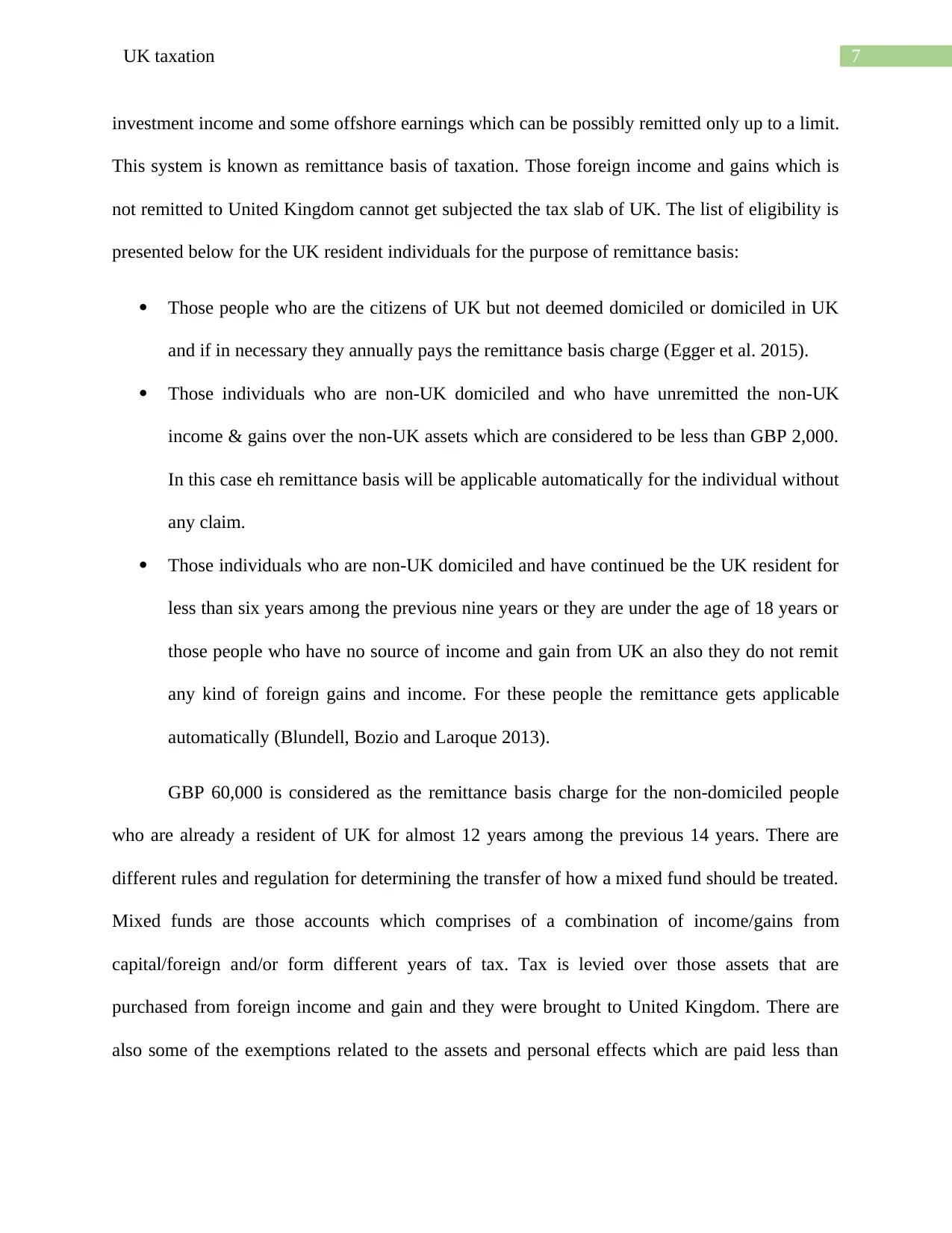
7UK taxation
investment income and some offshore earnings which can be possibly remitted only up to a limit.
This system is known as remittance basis of taxation. Those foreign income and gains which is
not remitted to United Kingdom cannot get subjected the tax slab of UK. The list of eligibility is
presented below for the UK resident individuals for the purpose of remittance basis:
Those people who are the citizens of UK but not deemed domiciled or domiciled in UK
and if in necessary they annually pays the remittance basis charge (Egger et al. 2015).
Those individuals who are non-UK domiciled and who have unremitted the non-UK
income & gains over the non-UK assets which are considered to be less than GBP 2,000.
In this case eh remittance basis will be applicable automatically for the individual without
any claim.
Those individuals who are non-UK domiciled and have continued be the UK resident for
less than six years among the previous nine years or they are under the age of 18 years or
those people who have no source of income and gain from UK an also they do not remit
any kind of foreign gains and income. For these people the remittance gets applicable
automatically (Blundell, Bozio and Laroque 2013).
GBP 60,000 is considered as the remittance basis charge for the non-domiciled people
who are already a resident of UK for almost 12 years among the previous 14 years. There are
different rules and regulation for determining the transfer of how a mixed fund should be treated.
Mixed funds are those accounts which comprises of a combination of income/gains from
capital/foreign and/or form different years of tax. Tax is levied over those assets that are
purchased from foreign income and gain and they were brought to United Kingdom. There are
also some of the exemptions related to the assets and personal effects which are paid less than
investment income and some offshore earnings which can be possibly remitted only up to a limit.
This system is known as remittance basis of taxation. Those foreign income and gains which is
not remitted to United Kingdom cannot get subjected the tax slab of UK. The list of eligibility is
presented below for the UK resident individuals for the purpose of remittance basis:
Those people who are the citizens of UK but not deemed domiciled or domiciled in UK
and if in necessary they annually pays the remittance basis charge (Egger et al. 2015).
Those individuals who are non-UK domiciled and who have unremitted the non-UK
income & gains over the non-UK assets which are considered to be less than GBP 2,000.
In this case eh remittance basis will be applicable automatically for the individual without
any claim.
Those individuals who are non-UK domiciled and have continued be the UK resident for
less than six years among the previous nine years or they are under the age of 18 years or
those people who have no source of income and gain from UK an also they do not remit
any kind of foreign gains and income. For these people the remittance gets applicable
automatically (Blundell, Bozio and Laroque 2013).
GBP 60,000 is considered as the remittance basis charge for the non-domiciled people
who are already a resident of UK for almost 12 years among the previous 14 years. There are
different rules and regulation for determining the transfer of how a mixed fund should be treated.
Mixed funds are those accounts which comprises of a combination of income/gains from
capital/foreign and/or form different years of tax. Tax is levied over those assets that are
purchased from foreign income and gain and they were brought to United Kingdom. There are
also some of the exemptions related to the assets and personal effects which are paid less than
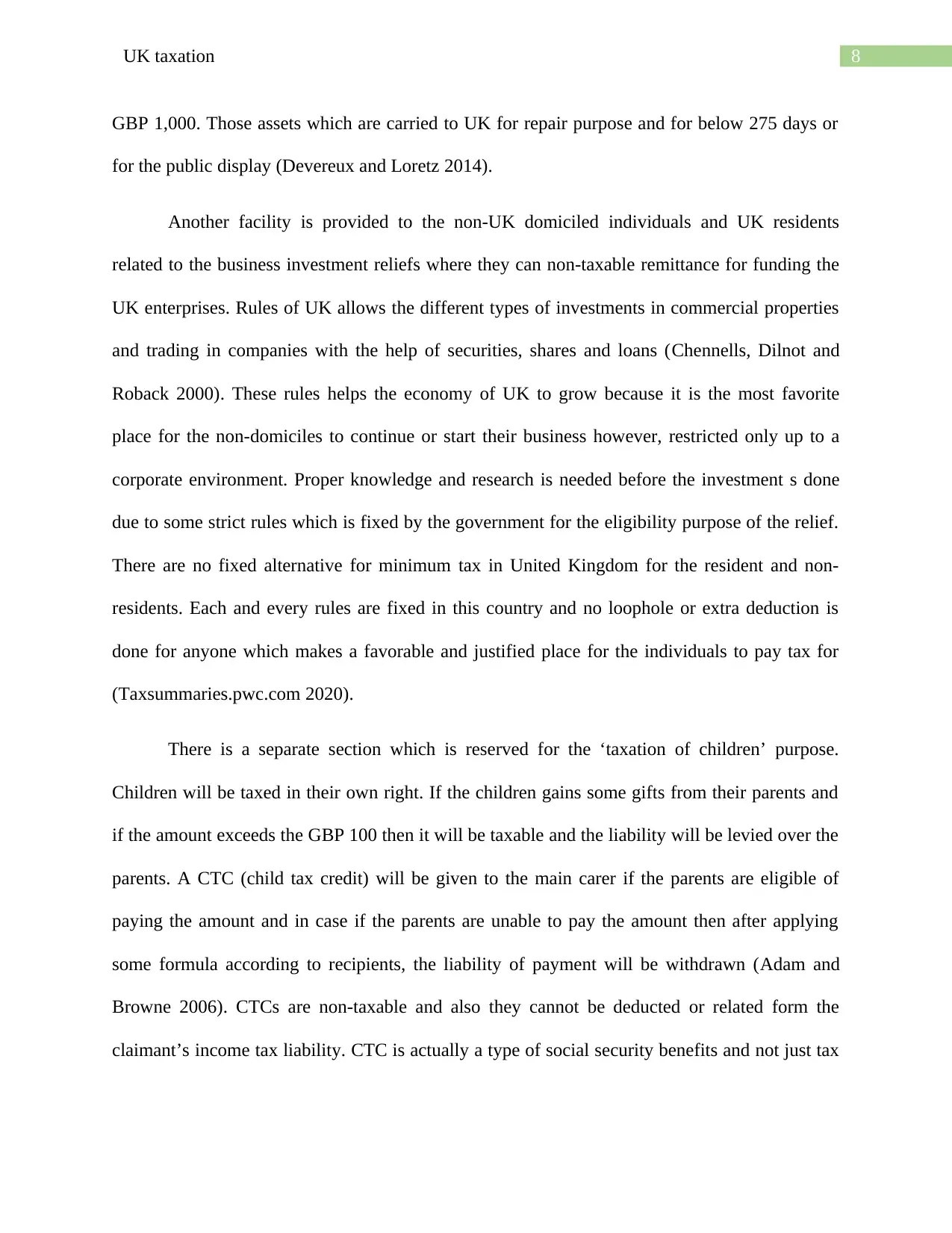
8UK taxation
GBP 1,000. Those assets which are carried to UK for repair purpose and for below 275 days or
for the public display (Devereux and Loretz 2014).
Another facility is provided to the non-UK domiciled individuals and UK residents
related to the business investment reliefs where they can non-taxable remittance for funding the
UK enterprises. Rules of UK allows the different types of investments in commercial properties
and trading in companies with the help of securities, shares and loans (Chennells, Dilnot and
Roback 2000). These rules helps the economy of UK to grow because it is the most favorite
place for the non-domiciles to continue or start their business however, restricted only up to a
corporate environment. Proper knowledge and research is needed before the investment s done
due to some strict rules which is fixed by the government for the eligibility purpose of the relief.
There are no fixed alternative for minimum tax in United Kingdom for the resident and non-
residents. Each and every rules are fixed in this country and no loophole or extra deduction is
done for anyone which makes a favorable and justified place for the individuals to pay tax for
(Taxsummaries.pwc.com 2020).
There is a separate section which is reserved for the ‘taxation of children’ purpose.
Children will be taxed in their own right. If the children gains some gifts from their parents and
if the amount exceeds the GBP 100 then it will be taxable and the liability will be levied over the
parents. A CTC (child tax credit) will be given to the main carer if the parents are eligible of
paying the amount and in case if the parents are unable to pay the amount then after applying
some formula according to recipients, the liability of payment will be withdrawn (Adam and
Browne 2006). CTCs are non-taxable and also they cannot be deducted or related form the
claimant’s income tax liability. CTC is actually a type of social security benefits and not just tax
GBP 1,000. Those assets which are carried to UK for repair purpose and for below 275 days or
for the public display (Devereux and Loretz 2014).
Another facility is provided to the non-UK domiciled individuals and UK residents
related to the business investment reliefs where they can non-taxable remittance for funding the
UK enterprises. Rules of UK allows the different types of investments in commercial properties
and trading in companies with the help of securities, shares and loans (Chennells, Dilnot and
Roback 2000). These rules helps the economy of UK to grow because it is the most favorite
place for the non-domiciles to continue or start their business however, restricted only up to a
corporate environment. Proper knowledge and research is needed before the investment s done
due to some strict rules which is fixed by the government for the eligibility purpose of the relief.
There are no fixed alternative for minimum tax in United Kingdom for the resident and non-
residents. Each and every rules are fixed in this country and no loophole or extra deduction is
done for anyone which makes a favorable and justified place for the individuals to pay tax for
(Taxsummaries.pwc.com 2020).
There is a separate section which is reserved for the ‘taxation of children’ purpose.
Children will be taxed in their own right. If the children gains some gifts from their parents and
if the amount exceeds the GBP 100 then it will be taxable and the liability will be levied over the
parents. A CTC (child tax credit) will be given to the main carer if the parents are eligible of
paying the amount and in case if the parents are unable to pay the amount then after applying
some formula according to recipients, the liability of payment will be withdrawn (Adam and
Browne 2006). CTCs are non-taxable and also they cannot be deducted or related form the
claimant’s income tax liability. CTC is actually a type of social security benefits and not just tax
⊘ This is a preview!⊘
Do you want full access?
Subscribe today to unlock all pages.

Trusted by 1+ million students worldwide

9UK taxation
credits in conventional sense. In UK the people are not asked to pay any kind of local taxes over
their incomes, neither for the non-residents nor for the residents.
credits in conventional sense. In UK the people are not asked to pay any kind of local taxes over
their incomes, neither for the non-residents nor for the residents.
Paraphrase This Document
Need a fresh take? Get an instant paraphrase of this document with our AI Paraphraser
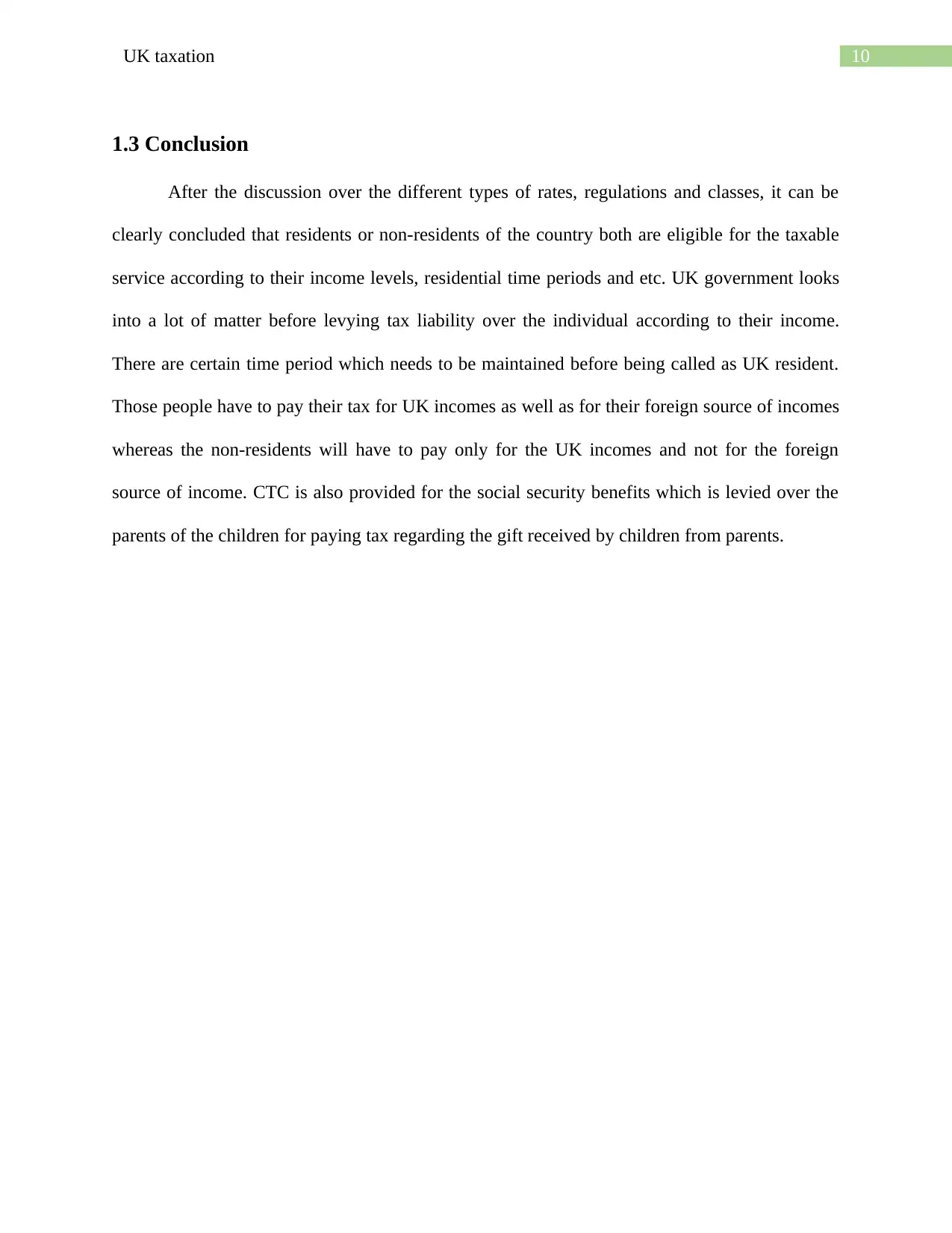
10UK taxation
1.3 Conclusion
After the discussion over the different types of rates, regulations and classes, it can be
clearly concluded that residents or non-residents of the country both are eligible for the taxable
service according to their income levels, residential time periods and etc. UK government looks
into a lot of matter before levying tax liability over the individual according to their income.
There are certain time period which needs to be maintained before being called as UK resident.
Those people have to pay their tax for UK incomes as well as for their foreign source of incomes
whereas the non-residents will have to pay only for the UK incomes and not for the foreign
source of income. CTC is also provided for the social security benefits which is levied over the
parents of the children for paying tax regarding the gift received by children from parents.
1.3 Conclusion
After the discussion over the different types of rates, regulations and classes, it can be
clearly concluded that residents or non-residents of the country both are eligible for the taxable
service according to their income levels, residential time periods and etc. UK government looks
into a lot of matter before levying tax liability over the individual according to their income.
There are certain time period which needs to be maintained before being called as UK resident.
Those people have to pay their tax for UK incomes as well as for their foreign source of incomes
whereas the non-residents will have to pay only for the UK incomes and not for the foreign
source of income. CTC is also provided for the social security benefits which is levied over the
parents of the children for paying tax regarding the gift received by children from parents.
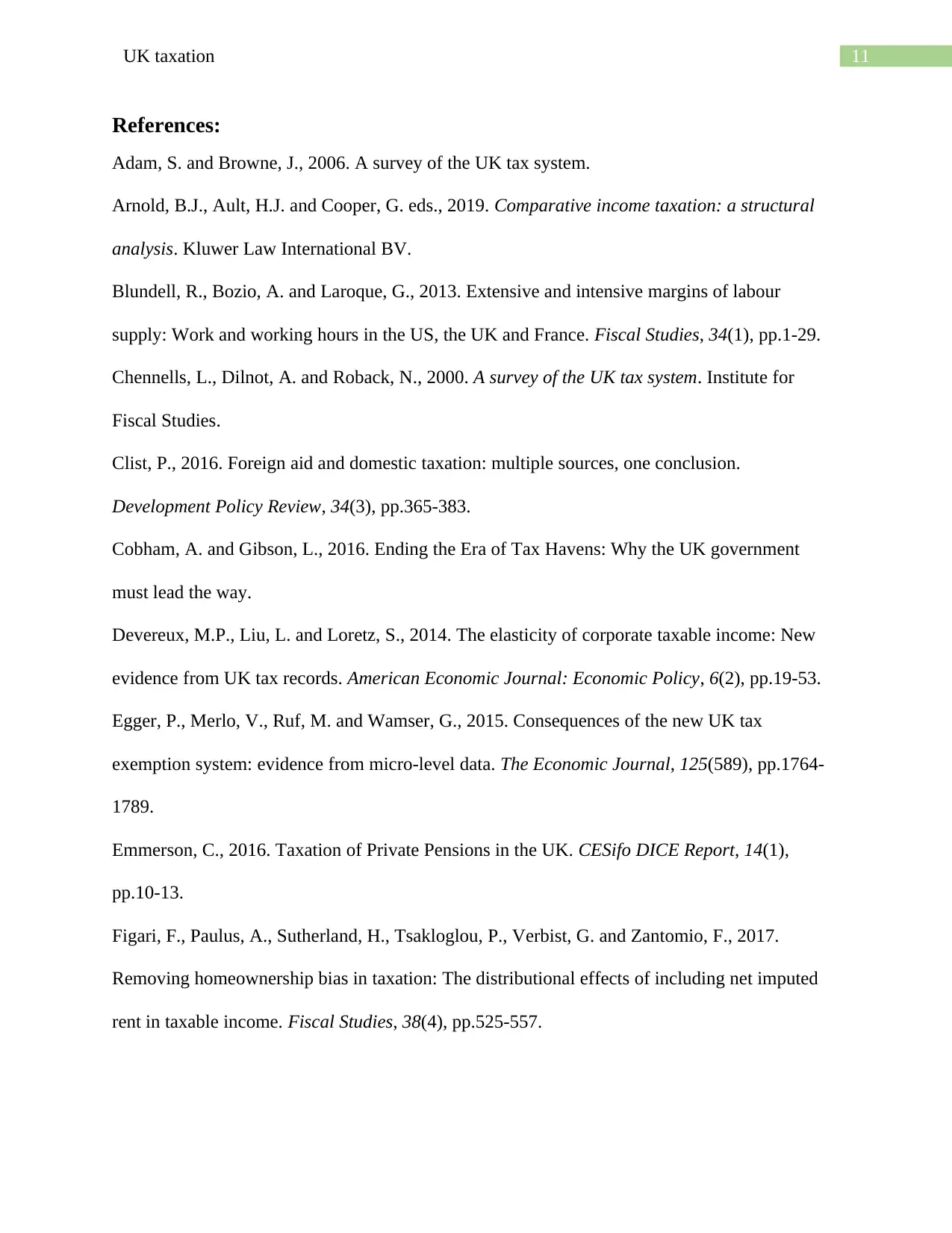
11UK taxation
References:
Adam, S. and Browne, J., 2006. A survey of the UK tax system.
Arnold, B.J., Ault, H.J. and Cooper, G. eds., 2019. Comparative income taxation: a structural
analysis. Kluwer Law International BV.
Blundell, R., Bozio, A. and Laroque, G., 2013. Extensive and intensive margins of labour
supply: Work and working hours in the US, the UK and France. Fiscal Studies, 34(1), pp.1-29.
Chennells, L., Dilnot, A. and Roback, N., 2000. A survey of the UK tax system. Institute for
Fiscal Studies.
Clist, P., 2016. Foreign aid and domestic taxation: multiple sources, one conclusion.
Development Policy Review, 34(3), pp.365-383.
Cobham, A. and Gibson, L., 2016. Ending the Era of Tax Havens: Why the UK government
must lead the way.
Devereux, M.P., Liu, L. and Loretz, S., 2014. The elasticity of corporate taxable income: New
evidence from UK tax records. American Economic Journal: Economic Policy, 6(2), pp.19-53.
Egger, P., Merlo, V., Ruf, M. and Wamser, G., 2015. Consequences of the new UK tax
exemption system: evidence from micro‐level data. The Economic Journal, 125(589), pp.1764-
1789.
Emmerson, C., 2016. Taxation of Private Pensions in the UK. CESifo DICE Report, 14(1),
pp.10-13.
Figari, F., Paulus, A., Sutherland, H., Tsakloglou, P., Verbist, G. and Zantomio, F., 2017.
Removing homeownership bias in taxation: The distributional effects of including net imputed
rent in taxable income. Fiscal Studies, 38(4), pp.525-557.
References:
Adam, S. and Browne, J., 2006. A survey of the UK tax system.
Arnold, B.J., Ault, H.J. and Cooper, G. eds., 2019. Comparative income taxation: a structural
analysis. Kluwer Law International BV.
Blundell, R., Bozio, A. and Laroque, G., 2013. Extensive and intensive margins of labour
supply: Work and working hours in the US, the UK and France. Fiscal Studies, 34(1), pp.1-29.
Chennells, L., Dilnot, A. and Roback, N., 2000. A survey of the UK tax system. Institute for
Fiscal Studies.
Clist, P., 2016. Foreign aid and domestic taxation: multiple sources, one conclusion.
Development Policy Review, 34(3), pp.365-383.
Cobham, A. and Gibson, L., 2016. Ending the Era of Tax Havens: Why the UK government
must lead the way.
Devereux, M.P., Liu, L. and Loretz, S., 2014. The elasticity of corporate taxable income: New
evidence from UK tax records. American Economic Journal: Economic Policy, 6(2), pp.19-53.
Egger, P., Merlo, V., Ruf, M. and Wamser, G., 2015. Consequences of the new UK tax
exemption system: evidence from micro‐level data. The Economic Journal, 125(589), pp.1764-
1789.
Emmerson, C., 2016. Taxation of Private Pensions in the UK. CESifo DICE Report, 14(1),
pp.10-13.
Figari, F., Paulus, A., Sutherland, H., Tsakloglou, P., Verbist, G. and Zantomio, F., 2017.
Removing homeownership bias in taxation: The distributional effects of including net imputed
rent in taxable income. Fiscal Studies, 38(4), pp.525-557.
⊘ This is a preview!⊘
Do you want full access?
Subscribe today to unlock all pages.

Trusted by 1+ million students worldwide
1 out of 13
Related Documents
Your All-in-One AI-Powered Toolkit for Academic Success.
+13062052269
info@desklib.com
Available 24*7 on WhatsApp / Email
![[object Object]](/_next/static/media/star-bottom.7253800d.svg)
Unlock your academic potential
Copyright © 2020–2025 A2Z Services. All Rights Reserved. Developed and managed by ZUCOL.





